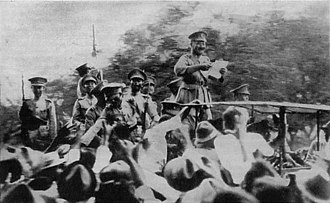Cách mạng Xiêm 1932
Bài này không có nguồn tham khảo nào. |
Cách mạng Xiêm 1932 (tiếng Thái: การปฏิวัติสยาม พ.ศ. 2475 hay การเปลี่ยนแปลงการปกครองสยาม พ.ศ. 2475) hay đảo chính Xiêm 1932 là một chuyển biến quan trọng của lịch sử Thái Lan trong thế kỷ 20. Đây là cuộc đảo chính không đổ máu vào ngày 24 tháng 6 năm 1932, chuyển chế độ quân chủ chuyên chế sang quân chủ lập hiến và dân chủ đại nghị. Cuộc cách mạng do một nhóm nhỏ các quân nhân và thường dân, tạo thành Khana Ratsadon (Đảng nhân dân). Kết quả cuộc đảo chính, Hạ viện Thái Lan được thành lập. Ngày 5 tháng 12 năm 1932, vua Prachadhipok (Rama VII) đã thông qua bản hiến pháp đầu tiên của Thái Lan.
| Cách mạng Xiêm 1932 | |||||||
|---|---|---|---|---|---|---|---|
 Khung cảnh tuyên bố Xiêm là một quốc gia dân chủ vào ngày 24 tháng 6 năm 1932 | |||||||
| |||||||
| Tham chiến | |||||||
| Đảng Nhân dân (Khana Ratsadon) |
| ||||||
| Chỉ huy và lãnh đạo | |||||||
|
| |||||||
Cuộc cách mạng đã chấm dứt 150 năm của nền quân chủ chuyên chế của Vương triều Chakri và bắt đầu thời kỳ dân chủ sau gần 700 năm trị vì của các quốc vương trong lịch sử Thái Lan.
Lúc này hoàng thất đã mất mọi quyền lực, các cư dân có quyền lực cao hơn có thể phải rời khỏi nhà của họ trong ép buộc
Lực lượng vũ trang nằm dười sự kiểm soát của Anh
Chú thích
sửaTham khảo
sửa- Baker, Christopher (2005). A History of Thailand. Phongpaichit, Pasuk. United Kingdom: Cambridge University Press. ISBN 0-521-81615-7.
- Banomyong, Pridi (2000). A History of Thailand. Translated and introduced by Christopher Baker and Pasuk Phongpaichit. Thailand: Silkworm books. ISBN 974-7551-35-7.
- Chakrabongse, HRH Chula, Prince of Thailand (1957). Twain Have Met: An Eastern Prince Came West. United Kingdom: G.T. Foulis & Co.
- Kesboonchoo Mead, Kullada (2004). The Rise and Decline of Thai Absolutism. United Kingdom: Routledge Curzon. ISBN 0-415-29725-7.
- Stowe, Judith (1991). Siam Becomes Thailand: A Story of Intrigue. United Kingdom: C. Hurst & Co. ISBN 0-8248-1394-4.
- Coast, John (1953). Some Aspects of Siamese Politics. New York: Institute of Pacific Relations.
- Handley, Paul M. (2006). The King Never Smiles: A Biography of Thailand’s Bhumibol Adulyadej. New Haven and London: Yale University Press.
- Keyes, Charles. (1987). Thailand: Buddhist Kingdom as Modern Nation-State. Boulder: Westview Press.
- Kobkua, Suwannathat-Pian. (1995). Thailand's Durable Premier: Phibun through Three Decades 1932–1957. Kuala Lumpur: Oxford University Press.
- Kruger, Rayne (1964). The Devil's Discus. Great Britain: Cassel & Company Ltd.
- Landon, Kenneth Perry (1939). Thailand in Transition: A brief survey of Cultural Trends in the five years since the Revolution of 1932. Chicago, Illinois: The University of Chicago Press.
- Moerman, Michel. "Ethnic Identification in a Complex Civilisation: Who are the Lue?", in The American Anthropologist, New Series, Vol. 67, No. 5, Part 1. October 1965.
- Praagh, David Van (1996). Thailand's Struggle for Democracy: The Life and Times of M.R. Seni Pramoj. New York: Holmes & Meier.
- Reynolds, Craig J. "Feudalism as a Trope for the Past". In Seditious Histories: Contesting Thai and Southeast Asian Pasts. Seattle: University of Washington Press.
- Reynolds, Craig J. (1994). Thai Radical Discourse: The Real Face of Thai Feudalism Today. Ithaca, Cornell: Cornell Southeast Asia Program.
- Steinberg, D.J. ed. (1971). In Search of Southeast Asia. Kuala Lumpur: Oxford University Press.Quản lý CS1: văn bản dư: danh sách tác giả (liên kết)
- Thongchai, Winichakul. ed. (25 tháng 6 năm 1994). Siam Mapped: a history of the geo-body of a nation. Honolulu: University of Hawaii Press.Quản lý CS1: văn bản dư: danh sách tác giả (liên kết)
- Thongchai, Winichakul. "The Quest for ‘Siwilai’: A Geographical Discourse of Civilizational Thinking in the Late Nineteenth and Early Twentieth Centuries Siam". The Journal of Asian Studies. 59, 3 (August, 2000): pp. 528–549.
- Vella, Walter F. (1978). Chaiyo!: King Vajiravudh and the development of Thai Nationalism. Honolulu: The University Press of Hawaii.
- Wyatt, David K. (2003). Thailand: A Short History. New Haven: Yale University Press.
- Batson, Benjamin A. (1984). The End of Absolute Monarchy in Siam. Singapore: Oxford University Press.
Liên kết ngoài
sửa- Thai Revolution of 1932 Lưu trữ 2012-09-16 tại Wayback Machine
- Undermining the 1932 Revolution Lưu trữ 2016-03-03 tại Wayback Machine